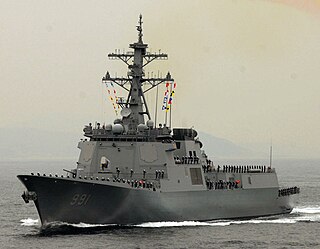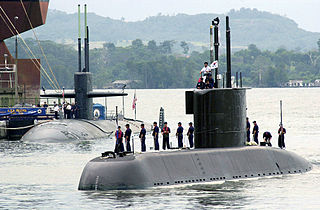
An attack submarine or hunter-killer submarine is a submarine specifically designed for the purpose of attacking and sinking other submarines, surface combatants and merchant vessels. In the Soviet and Russian navies they were and are called "multi-purpose submarines". They are also used to protect friendly surface combatants and missile submarines. Some attack subs are also armed with cruise missiles, increasing the scope of their potential missions to include land targets.

The Republic of Korea Navy, also known as the ROK Navy or South Korean navy, is the naval warfare service branch of the South Korean armed forces, responsible for naval and amphibious operations. The ROK Navy includes the Republic of Korea Marine Corps, which functions as a branch of the Navy. The ROK Navy has about 70,000 regular personnel including 29,000 Republic of Korea Marines. There are about 160 commissioned ships with the ROK Navy. The naval aviation force consists of about 70 fixed-wing and rotary-wing aircraft. The ROK Marine Corps has about 300 tracked vehicles including assault amphibious vehicles.
Yi Eok-gi was the commander of the Eastern Jeolla Fleet and later came to be the commander of the Western Jeolla Fleet. At age 32, despite being 15 years younger than Supreme Naval Commander Yi Sun-sin, Yi Eok-gi became his most trusted commander and companion during the Seven Year War. Yi Eok-gi was eventually killed in the devastating Battle of Chilcheollyang Strait while assisting Won Gyun, the Naval Commander of the entire Korean navy at that time.

The Korean Attack Submarine program, KSS meaning Submarine, is a three-phased project to build up the Republic of Korea Navy 's attack submarine arsenal. Before the KSS program, the submarine fleet of the ROK Navy consisted of midget submarines, such as the Dolgorae class submarine and SX 756 Dolphin class submarine, which had limited capabilities for inshore operations. The KSS program sought to acquire submarines that can deter hostile submarines and surface ships; protect friendly naval bases and sea shores communications; carry out reconnaissance missions.

The Type 209 is a class of diesel-electric attack submarine developed exclusively for export by Howaldtswerke-Deutsche Werft of Germany. The original variant was designed in the late 1960s. The class is exclusively designed for export market. Despite not being operated by the German Navy, five variants of the class have been successfully exported to 13 countries, with 61 submarines being built and commissioned between 1971 and 2008.

The naval history of Korea dates back thousands of years since the prehistoric times when simple fishing ships were used. Military naval history dates back to the Three Kingdoms period and Unified Silla dynasties of Korea in the 7th century. Because of the constant coastal attacks by the Wa Japanese and other barbarian tribes, Korean shipbuilding excelled to counter these threats as a result. During the Unified Silla period, Jang Bogo, a merchant, rose as an admiral and created the first maritime trading within East Asian countries. During the Goryeo dynasty, sturdy wooden ships were built and used to fight pirates. Korean shipbuilding again excelled during the Imjin war, when Admiral Yi defeated the advancing Japanese fleets.
The Republic of Korea Navy was founded on November 11, 1945 as Marine Defense Group after Korea was liberated from the Empire of Japan. The ROK Navy is the oldest service within the ROK Armed Forces. In 2015, the South Korean navy celebrated its 70th anniversary.

ROKS Jang Bogo (SS-061) is the lead ship of the Jang Bogo-class submarine of the Republic of Korea Navy, and was the first submarine to serve with the navy. She is one of the Type 209 submarines built for export by Germany.

The Jang Bogo-class submarine is a variant of the Type 209 diesel-electric attack submarine initially developed by Howaldtswerke-Deutsche Werft (HDW) of Germany, intended for service with the South Korean Navy and Indonesian Navy. A Daewoo (DSME)-upgraded model of the Jang Bogo class Type 209 was exported by Korea to Indonesia in 2012, amid heavy competition from Russian, French, and German-Turkish consortiums including from Germany's original Type 209. The variant was considered for possible purchase by Thailand as well, as both newly built and second-hand options. The class is named for ancient Korean maritime figure Jang Bogo.

The Nagapasa class is an upgraded variant of the Jang Bogo class, also known as Improved Chang Bogo. The vessels were built by the South Korean Daewoo Shipbuilding & Marine Engineering (DMSE) and the Indonesian PT PAL. As of 2021, six ships have been planned, which were divided into two batches. Batch 1 consists of three ships and all are already commissioned. Batch 2 also consists of three ships that are in the early development stage.

ROKS Sejong the Great (DDG-991) is the lead ship of the her class of guided missile destroyer built for the Republic of Korea Navy. She was the first Aegis-built destroyer of the service and was named after the fourth king of the Joseon dynasty of Korea, Sejong the Great.

ROKS Wang Geon (DDH-978) is a Chungmugong Yi Sun-sin-class destroyer in the Republic of Korea Navy. She is named after Wang Geon.

ROKS Yi Cheon (SS-062) is the second ship of the Jang Bogo-class submarine of the Republic of Korea Navy, and was the second submarine to serve with the navy. She is one of Jang Bogo-class submarines to be built in South Korea.

ROKS Choe Museon (SS-063) is the third ship of the Jang Bogo-class submarine of the Republic of Korea Navy, and was the second submarine to serve with the navy. She is one of Jang Bogo-class submarines to be built in South Korea.

ROKS Park Wi (SS-065) is the fourth ship of the Jang Bogo-class submarine of the Republic of Korea Navy, and was the third submarine to serve with the navy. She is one of Jang Bogo-class submarines to be built in South Korea.

ROKS Lee Jongmoo (SS-066) is the fifth ship of the Jang Bogo-class submarine of the Republic of Korea Navy, and was the fourth submarine to serve with the navy. She is one of Jang Bogo-class submarines to be built in South Korea.

ROKS Jung Woon (SS-067) is the sixth boat of the Jang Bogo-class submarine of the Republic of Korea Navy. She is one of Jang Bogo-class submarines to be built in South Korea.

ROKS Yi Sun-sin (SS-068) is the seventh boat of the Jang Bogo-class submarine of the Republic of Korea Navy. She is one of Jang Bogo-class submarines to be built in South Korea.

ROKS Na Dae-yong (SS-069) is the eighth boat of the Jang Bogo-class submarine of the Republic of Korea Navy. She is one of Jang Bogo-class submarines to be built in South Korea.

















